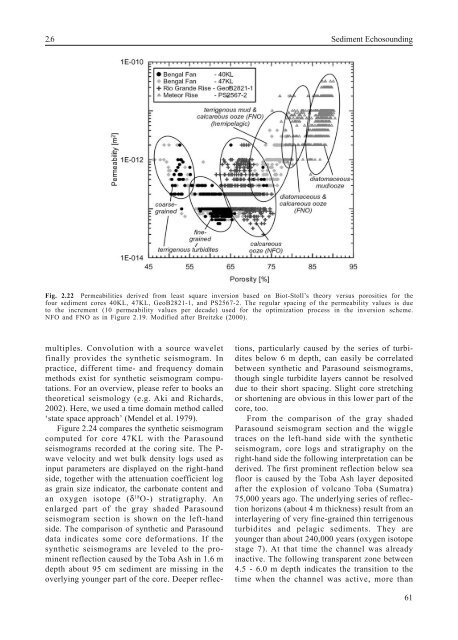2 Physical Properties of Marine Sediments - Blogs Unpad
2 Physical Properties of Marine Sediments - Blogs Unpad
2 Physical Properties of Marine Sediments - Blogs Unpad
Create successful ePaper yourself
Turn your PDF publications into a flip-book with our unique Google optimized e-Paper software.
2.6 Sediment EchosoundingFig. 2.22 Permeabilities derived from least square inversion based on Biot-Stoll’s theory versus porosities for thefour sediment cores 40KL, 47KL, GeoB2821-1, and PS2567-2. The regular spacing <strong>of</strong> the permeability values is dueto the increment (10 permeability values per decade) used for the optimization process in the inversion scheme.NFO and FNO as in Figure 2.19. Modified after Breitzke (2000).multiples. Convolution with a source waveletfinally provides the synthetic seismogram. Inpractice, different time- and frequency domainmethods exist for synthetic seismogram computations.For an overview, please refer to books antheoretical seismology (e.g. Aki and Richards,2002). Here, we used a time domain method called‘state space approach’ (Mendel et al. 1979).Figure 2.24 compares the synthetic seismogramcomputed for core 47KL with the Parasoundseismograms recorded at the coring site. The P-wave velocity and wet bulk density logs used asinput parameters are displayed on the right-handside, together with the attenuation coefficient logas grain size indicator, the carbonate content andan oxygen isotope (δ 18 O-) stratigraphy. Anenlarged part <strong>of</strong> the gray shaded Parasoundseismogram section is shown on the left-handside. The comparison <strong>of</strong> synthetic and Parasounddata indicates some core deformations. If thesynthetic seismograms are leveled to the prominentreflection caused by the Toba Ash in 1.6 mdepth about 95 cm sediment are missing in theoverlying younger part <strong>of</strong> the core. Deeper reflections,particularly caused by the series <strong>of</strong> turbiditesbelow 6 m depth, can easily be correlatedbetween synthetic and Parasound seismograms,though single turbidite layers cannot be resolveddue to their short spacing. Slight core stretchingor shortening are obvious in this lower part <strong>of</strong> thecore, too.From the comparison <strong>of</strong> the gray shadedParasound seismogram section and the wiggletraces on the left-hand side with the syntheticseismogram, core logs and stratigraphy on theright-hand side the following interpretation can bederived. The first prominent reflection below seafloor is caused by the Toba Ash layer depositedafter the explosion <strong>of</strong> volcano Toba (Sumatra)75,000 years ago. The underlying series <strong>of</strong> reflectionhorizons (about 4 m thickness) result from aninterlayering <strong>of</strong> very fine-grained thin terrigenousturbidites and pelagic sediments. They areyounger than about 240,000 years (oxygen isotopestage 7). At that time the channel was alreadyinactive. The following transparent zone between4.5 - 6.0 m depth indicates the transition to thetime when the channel was active, more than61
















